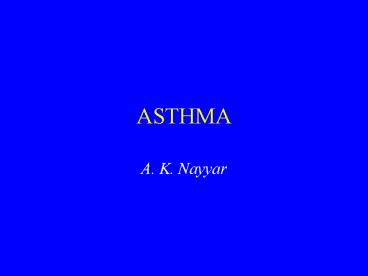ASTHMA - PowerPoint PPT Presentation
1 / 22
Title: ASTHMA
1
ASTHMA
- A. K. Nayyar
2
Definition
- It is a syndrome characterized by AIRFLOW
OBSTRUCTION that varies markedly, both
spontaneously and with treatment. - Narrowing of the airways is usually reversible,
but in some patients with chronic asthma there
may be an element of irreversible airflow
obstruction
3
Cont.
- It is characterized
- pathologically by bronchial inflammation with
prominent eosinophil infiltration
physiologically by bronchial hype-reactivity,
and - clinically by variable cough, chest tightness and
wheeze
4
Epidemiology
- It affects approximately 10-15 of children and
5-10 of adults - Prevalence is greater in industrialized countries
- Prevalence is increasing world-wide
5
Pathology of asthma
- Infiltration with inflammatory cells (esp.
eosinophils and T-lymphocytes) - Patchy epithelial shedding
- Airway smooth muscle thickening
- Subepithelial fibrosis
- Mucus gland and goblet cell hyperplasia
- widespread mucus plugging in fatal asthma
6
Mechanisms of asthma
- Inflammation underlies airway hyperresponsiveness
- The inflammation is of characteristic pattern and
it involves interaction between many inflammatory
cells - This results in the release of multiple
inflammatory mediators - Inflammatory mediators result in
bronchoconstriction, mucus secrition, exudation
of plasma and airway hyperresponsiveness
7
Cont.
- Neural mechanism may amplify the asthmatic
inflammation - Structural changes may occur with subepithelial
fibrosis, airway smooth muscle hyperplasia and
new vessel formation. These changes may underlie
irreversible airflow obstruction
8
Types of asthma
- Allergic (extrinsic) asthma
- Non-allergic (intrinsic) asthma
- Occupational asthma
- Aspirin induced asthma
- Asthma of infancy(lt2 yr of age)
9
Allergic asthma
- Onset usually in childhood
- May persist into adulthood
- Remission in adolescence is common
- Associated with allergic rhinitis and atopic
dermatitis in variable combination
10
Intrinsic asthma
- Onset in adults
- No external inciter is recognized
- Often associated with perennial non-allergic
rhinitis - Accounts for approx. 10 of adult asthma
11
Occupational asthma
- Due to exposure to chemical sensitizers at work
- Unrelated to atopic status
- Some occur in atopics due to allergen exposure at
work
12
Aspirin induced asthma
- Special type of intrinsic asthma
- It is a metabolic, pharmacological disorder
- acute asthma attacks on first and subsequent
exposure to aspirin and NSAID
13
Asthma of infancy
- Recurrent bouts of significant airflow limitation
in small airways from viral infections - Often remits as child gets older
- not associated with atopy
- Sometimes called wheezy bronchitis
14
Clinical features
- Symptoms
- Triggers
- Physical signs
15
Symptoms
- Wheeze-- intermittent, worse on expiration,
chracteristically relieved by an inhaled ß2-
agonist - Cough-- usually unproductive
- Chest tightness
- SOB
- Prodromal symptoms may precede an attack
16
Triggers
- Allergens (house dust mite, pollen, animal
dander, moulds) - Irritants (tobacco smoke, air pollutants, strong
odours, fumes) - Physical factors (exercise, cold air,
hyperventillation, laughter, crying) - Upper respiratory tract viral infections
- Emotions
- Occupational agents (chemical sensitizers,
allergens) - Drugs (beta blockers,NSAID)
- Food additives (metabisulphite,tartrazine)
- Change in weather
- Endocrine factors (menstrual cycle,
pregnancy,thyroid disease)
17
Physical signs
- Expiratory ronchi- widespread
- Hyperinflation of chest
- Use of accessory muscles
- Associated signs nasal polyps, flexure eczema
18
Features suggestive of asthma in young children
- Symptom free intervals
- Nocturnal cough
- Coughing after exercise
- Coughing when laughing or crying
- Good response to correctly inhled or nebulized
bronchodilators - Personal or family history of atopic disease
- Onset unrelated to respiratory syncytial virus
infection
19
Features suggestive of alternative diagnosis in
young children
- Failure to thrive(? Cystic fibrosis,
immunodeficiency) - Absence of symptom free interval
- Sudden onset of persistent symptoms
- Persistent URTI/ otitis (? ciliary dyskinesia)
- Vomiting / recurrent pneumonia(? Acid reflux,
aspiration) - Premature birth (?bronchopulmonary dysplasia)
- Onset in RS virus season(?Post RSV broncholitis)
20
DD in adults
- Mechanical obstruction of airways
- COPD
- Heart failure
- PE
- Vasculitides
- Carcinoid syndrome with hepatic secondaries
21
Principles of treatment
- Educate patients to develop a partnership in
asthma management - Assess and monitor severity with objective
measurement of lung function - Avoid or control asthma triggers
- Establish medication plans for chronic management
- Establish plans for managing exacerbations
- Provide regular follow-up care
22
Clinical evaluation of severity
- Number of daytime attacks lasting more than 24
hrs and needing extra medication - The presence of completely symptom-free intervals
lasting more than 4 weeks without medication - The frequency of waking at night due to asthma
symptoms - The amount of absence from work or school because
of asthma - The ability of the patients to keep up with peers
in normal physical activity - The number and type of medications required on
regular basis - The frequency of using extra relief medications
on an as needed basis - The frequency of hospital admission
- The of life-threatening episodes































